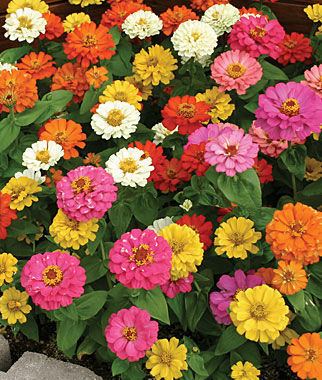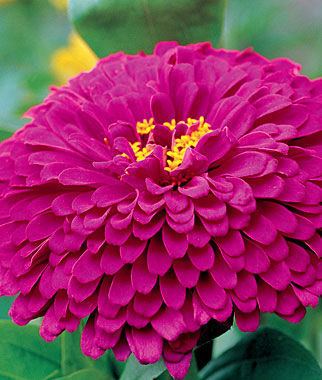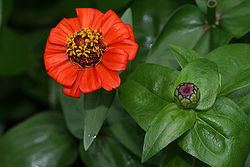Scientific name Zinnia Rank Genus | ||
Lower classifications Zinnia elegans, Zinnia angustifolia, Zinnia acerosa | ||
All about zinnia flowers
Zinnia is a genus of plants of the sunflower tribe within the daisy family. They are native to scrub and dry grassland in an area stretching from the Southwestern United States to South America, with a centre of diversity in Mexico. Members of the genus are notable for their solitary long-stemmed flowers that come in a variety of bright colors. The genus name honors German master botanist Johann Gottfried Zinn (1727–59).
Contents
- All about zinnia flowers
- How to plant zinnia seeds in a pot garden seed starting
- Description
- Species
- Uses
- Beyond Earth
- Companion plants
- References

How to plant zinnia seeds in a pot garden seed starting
Description
Zinnias are annuals, shrubs, and sub-shrubs native primarily to North America, with a few species in South America. Most species have upright stems but some have a lax habit with spreading stems that mound over the surface of the ground. They typically range in height from 10 to 100 cm tall (4" to 40"). The leaves are opposite and usually stalkless (sessile), with a shape ranging from linear to ovate, and a color ranging from pale to medium green. The flowers have a range of appearances, from a single row of petals to a dome shape. Zinnias may be white, chartreuse, yellow, orange, red, purple, or lilac.
Species

- Zinnia acerosa – Utah Arizona New Mexico Texas Coahuila, Durango, Nuevo León, San Luis Potosí, Michoacán, Zacatecas, Sonora
- Zinnia americana – Guerrero, Jalisco, Michoacán, México State, Nayarit, Veracruz, Oaxaca, Chiapas, Guatemala, Honduras, Nicaragua
- Zinnia angustifolia – Jalisco, Durango, Chihuahua, Sinaloa, San Luis Potosí
- Zinnia anomala – Texas, Coahuila, Nuevo León
- Zinnia bicolor – Chihuahua, Durango, Jalisco, Guanajuato, Nayarit, Sinaloa
- Zinnia citrea – Chihuahua, Coahuila, San Luis Potosí
- Zinnia elegans from Jalisco to Paraguay; naturalized in parts of United States
- Zinnia flavicoma – Michoacán, Oaxaca, Guerrero, Jalisco
- Zinnia grandiflora – Arizona New Mexico Texas Oklahoma Kansas Colorado Tamaulipas, Nuevo León, Coahuila, Chihuahua, Sonora
- Zinnia haageana – Guanajuato, Jalisco, Michoacán, México State, Oaxaca
- Zinnia juniperifolia – Tamaulipas, Nuevo León, Coahuila
- Zinnia maritima – Guerrero, Colima, Jalisco, Nayarit, Sinaloa
- Zinnia microglossa – Guanajuato, Jalisco
- Zinnia oligantha – Coahuila
- Zinnia palmeri – Colima, Jalisco
- Zinnia pauciflora Phil.
- Zinnia peruviana – widespread from Chihuahua to Paraguay including Galápagos and West Indies; naturalized in parts of China, South Africa, United States
- Zinnia pumila A.Gray
- Zinnia purpusii – Chiapas, Guerrero, Colima, Jalisco, Puebla
- Zinnia tenuis – Chihuahua
- Zinnia venusta – Guerrero
- Zinnia violacea – Mexico, Central America, Colombia, Venezuela
- Zinnia zinnioides (Kunth) Olorode & Torres

Zinnia elegans, also known as Zinnia violacea, is the most familiar species, originally from the warm regions of Mexico being a warm–hot climate plant. Its leaves are lance-shaped and sandpapery in texture, and height ranges from 15 cm to 1 meter.

Zinnia angustifolia is another Mexican species. It has a low bushy plant habit, linear foliage, and more delicate flowers than Z. elegans – usually single, and in shades of yellow, orange or white. It is also more resistant to powdery mildew than Z. elegans, and hybrids between the two species have been raised which impart this resistance on plants intermediate in appearance between the two. The Profusion series, with both single and double-flowered components, is bred by Sakata of Japan, and is among the most well-known of this hybrid group.
Zinnias seem to be a favorite of butterflies, and many gardeners add zinnias specifically to attract them.
Uses

Zinnias are popular garden flowers because they come in a wide range of flower colors and shapes, and they can withstand hot summer temperatures, and are easy to grow from seeds. They are grown in fertile, humus-rich, and well-drained soil, in an area with full sun. They will reseed themselves each year. Over 100 cultivars have been produced since selective breeding started in the 19th century.
Zinnia peruviana was introduced to Europe in the early 1700s. Around 1790 Z. elegans (Zinnia violacea) was introduced and those plants had a single row of ray florets which were violet. In 1829, scarlet flowering plants were available under the name 'Coccinea'. Double flowering types were available in 1858, coming from India, and they were in a range of colors including shades of reds, rose, purple, orange, buff, and rose stripped. In
time, they came to represent thinking of absent friends in the language of flowers.
A number of species of zinnia are popular flowering plants, and interspecific hybrids are becoming more common. Their varied habits allow for uses in several parts of a garden, and their tendency to attract butterflies and hummingbirds is seen as desirable. Commercially available seeds and plants are derived from open pollinated or F1 crosses, and the first commercial F1 hybrid dates from 1960.
Beyond Earth
In January 2016, NASA announced that a zinnia which had blossomed on the International Space Station was the first flower ever grown outside the Earth's biosphere. This claim was quickly refuted by news media.
Companion plants
In the Americas their ability to attract hummingbirds is also seen as useful as a defense against whiteflies, and therefore zinnias are a desirable companion plant, benefiting plants that are inter-cropped with it. Zinnias are grown in the summertime.
